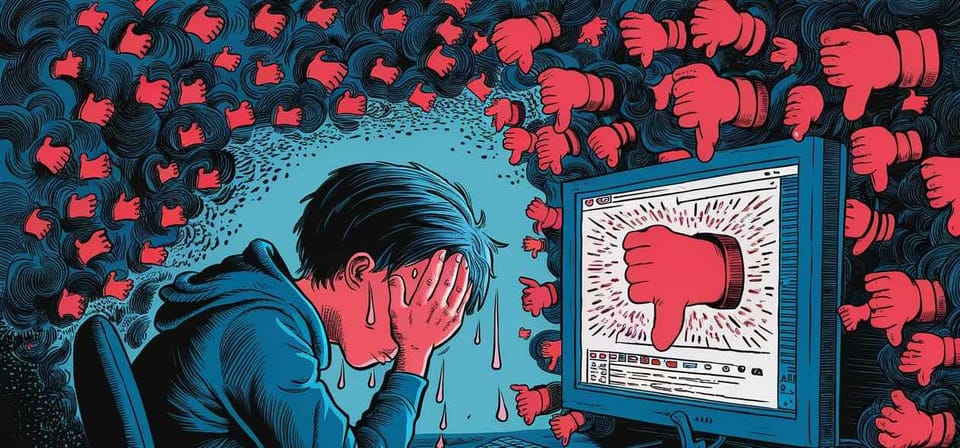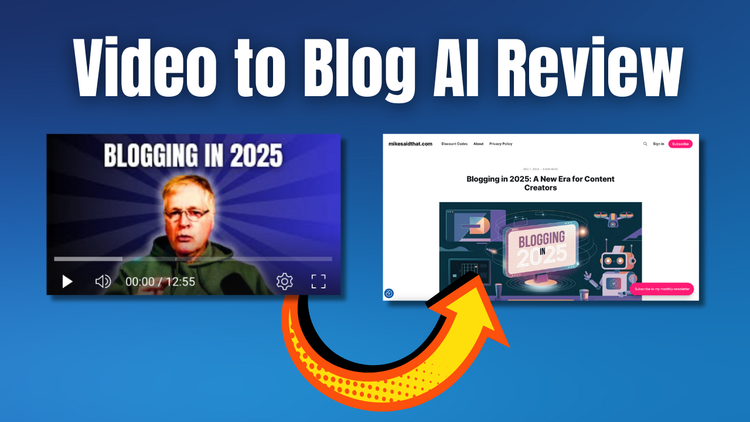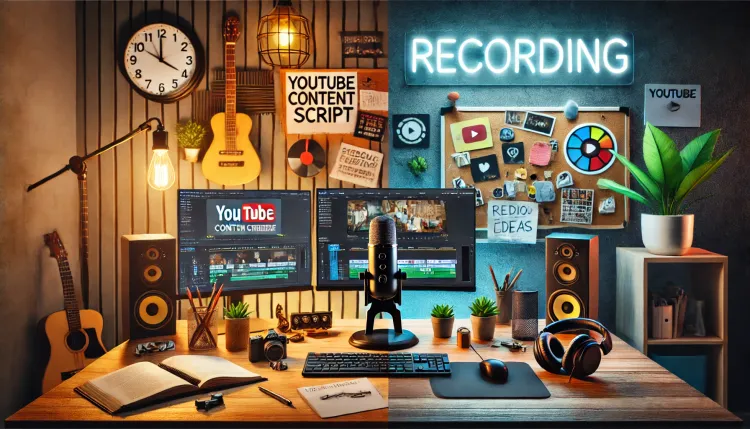Do YouTube Dislikes Matter? The Impact on Creators and Videos Explained

Ever thought about if hitting the thumbs-down button on YouTube counts for anything? The world of YouTube dislikes is more complex than it seems.
Creators worry about how dislikes affect their success and the algorithm, while viewers use them to show they're unhappy. But do these dislikes really play a big role in YouTube's ecosystem and algorithm?
In November 2021, YouTube made a big change by hiding dislike counts from everyone. Some saw it as a way to stop targeted dislike attacks, while others thought it took away important feedback for creators and viewers.
A few weeks since the change was made, has dislikes being removed negatively affected how you use YouTube?
— Paddy Galloway (@PaddyG96) December 14, 2021
Recent studies have shown that dislikes might not have as big an impact on the YouTube algorithm as we thought. A Mozilla study found that dislikes only stopped about 12% of unwanted video recommendations. This news challenges the idea that dislikes really affect a video's success or a creator's growth.
Even with these findings, dislikes still have a role. They give creators clues about what viewers like and don't like, helping them make better content. Many successful YouTubers keep an eye on their like-to-dislike ratios. This helps them make their videos better and understand their audience better.
I do think they are really important because they tell me when I've missed the mark on content. Unhappy viewers will affect your engagement metrics and they certainly won't be coming back to watch any of your content.
Key Takeaways
- YouTube hid public dislike counts in November 2021, sparking controversy
- Dislikes seem to have limited influence on YouTube's recommendation algorithm
- Content creators can use dislike data to improve their videos
- The impact of dislikes on channel growth is less significant than often believed
- Viewer feedback, including dislikes, remains valuable for content improvement
Understanding the YouTube Dislike Button: A Brief History
YouTube's dislike button has sparked a lot of debate since it started. It lets viewers show they don't like a video, which affects what videos get recommended and how creators are seen. When YouTube decided to hide dislike counts in 2021, it changed how feedback works on the site.
The 2021 Decision to Hide a YouTube Videos Dislike Counts
In November 2021, YouTube made a big move by hiding dislike counts from everyone. This move caused a lot of talk among creators and viewers. Even though the dislike button is still there, people can't see how many dislikes a video has anymore.
YouTube's Rationale for Hiding Dislikes
YouTube said it hid dislike counts to protect creators from getting attacked by dislikes. They wanted to make a place where creators feel safe and happy. This was especially true since big companies had some of the most disliked videos.
YouTubers and Viewer Reactions to the Change
People had different opinions about hiding dislike counts. Some creators liked not getting attacked, while others said the dislike count helped viewers know if a video was good. Viewers were worried they'd lose a way to check if a video was trustworthy.
| Perspective | Pros | Cons |
|---|---|---|
| Creators | Protection from targeted attacks | Loss of public feedback metric |
| Viewers | Reduced negative bias | Difficulty in assessing content quality |
| YouTube | Improved creator well-being | Potential loss of transparency |
Even with the debate, YouTube believes the change helps creators feel better. They still give creators dislike metrics in YouTube Studio. This lets creators see how their videos are doing and make them better based on what viewers say.
The Psychological Impact of Dislikes on Channel Creators
YouTube content creators face a big challenge with negative feedback. The change to hide dislike counts has sparked debates. It affects their mental health and how well their channels do.
Before, some creators stopped making videos because of harsh dislike attacks. This shows how negative feedback can really hurt creators, especially new ones.
Even though dislikes are hidden, creators can still see them in YouTube Studio. This lets them check their performance without public pressure. Experienced creators see dislikes as a chance to get better and improve their videos. I hate dislikes because I've missed the mark on the content I provided. It could mean:
- My thumbnail was misleading
- My description wasn't clear
- My content wasn't helpful
Dislikes also affect a creator's whole channel and how people see their work. The new system tries to protect creators while keeping valuable feedback from viewers.
Do Dislikes Matter to a YouTube Channel? Analyzing the Algorithm Response
YouTube's algorithm is complex, deciding what videos you see. Many creators ask if dislikes affect their video's visibility. Let's explore how dislikes affect video recommendations and compare them with other feedback.
How Dislikes Influence Viewership and Video Recommendations
Dislikes do play a part in YouTube's algorithm, but their effect might be smaller than expected. A Mozilla study showed that the dislike button only stopped about 12% of unwanted recommendations. This means dislikes are considered, but they're not the top factor in what videos YouTube suggests.
Comparing Dislike Button to Other Feedback Mechanisms
Not all feedback is the same. The "Don't Recommend Channel" option was more effective, stopping 43% of unwanted suggestions. This shows that feedback about a channel is more important in YouTube's algorithm than just disliking a video.
| Feedback Mechanism | Effectiveness in Preventing Unwanted Recommendations |
|---|---|
| Dislike Button | 12% |
| "Don't Recommend Channel" | 43% |
| Watch Time | High (Exact % not available) |
| Engagement (Comments, Shares) | Significant (Exact % not available) |
While dislikes are important, they're just one part of the puzzle. YouTube looks at many things like watch time, engagement, and what users like when picking videos to recommend. Creators should aim to make content that connects with their audience.
Worrying too much about dislikes isn't the best strategy, but when you see a video with a high ratio of dislikes to likes, you need to examine that content and see if you can figure out why this is the case.
Lastly, one thing I've noticed is a video you create that goes too far outside of the scope of your niche can get lot's of dislikes. If you normally talk about cars and decide to do a random video about tractors, expect to get dislikes. It's evidence your subscribers aren't happy.
The Role of Dislikes in YouTube's Recommendation System
YouTube's recommendation algorithm is complex, looking at many factors to suggest videos. The dislike button does play a role, but its effect on what you see might be less than you think.
The algorithm looks more at positive actions like watch time and likes to decide what to recommend. Yet, dislikes still matter for how you find new videos and what you watch.
A study by Mozilla found that the dislike button only stops about 12% of similar video suggestions. This means dislikes don't greatly change what you see. But, the "Don't recommend this channel" option works better, stopping about 43% of the time.
The algorithm uses over 80 billion pieces of info to match content with viewers. This includes your watch history, what channels you follow, and where you are. Dislikes are just one small part of this big data set.
For creators, knowing how dislikes affect the recommendation system is key. A lot of dislikes can hurt a video's success by making viewers leave early. This shows why making content that people like is so important.
"Responsible recommendations on YouTube are crucial for maintaining a platform that connects viewers to high-quality information while minimizing problematic content."
YouTube is always working to make its recommendations better and more responsible. The goal is to give you content you'll like while keeping out harmful stuff. This helps make viewers happier and keeps the platform safe.
Interpreting Dislike Data: What Creators Can Learn
Understanding dislike data is key for YouTube creators who want to make better content. The YouTube Creator Studiogives them insights into what viewers think, including the dislike metric.
Accessing Dislike Metrics in YouTube Creator Studio
Creators can find dislike data in the YouTube Creator Studio analytics section. This includes views, watch time, and the dislike ratio. This ratio shows how well the audience likes the video.
Analyzing Dislike Ratios and Patterns
A spike in dislikes might mean the content didn't hit the mark. Creators should look for patterns in their videos. A high dislike ratio on certain topics could mean they need to try something new.
Using Dislike Feedback for Content Improvement
Dislike data is a strong tool for making content better. By looking at this feedback, creators can adjust their style to better match what the audience wants. Here are some ways to use dislike data:
- Identify topics or styles that consistently receive more dislikes
- Compare dislike ratios with other engagement metrics
- Use dislike spikes as cues to review and potentially revise content
- Consider viewer comments alongside dislike data for context
By using these insights, creators can make smart choices to improve their content strategy. This helps them do better on YouTube.
The Viewer's Perspective: Why People Dislike Videos
Many people dislike YouTube videos for various reasons. Misleading titles or thumbnails often get negative feedback. Poor content quality also leads viewers to hit the dislike button. Sometimes, people just don't agree with the video's message.
Interestingly, dislikes aren't always negative for creators. They can signal engagement to YouTube's algorithm, which might boost a video's visibility. This shows how complex viewer behavior can be on the platform.
Some viewers use dislikes as a way to give silent feedback. They don't want to leave a detailed comment. This helps creators quickly understand audience reactions. Knowing these reasons can help improve videos and address issues.
"Dislikes are essential audience feedback, aiding creators in improving video content quality."
The hidden dislike count has changed how viewers see content quality at first glance. Now, they look at other factors to judge a video's worth before watching. This change has affected the viewer-creator dynamic on the platform.
- Misleading titles or thumbnails
- Poor content quality
- Disagreement with the video's message
- Silent feedback method
In conclusion, dislikes are a valuable tool for both viewers and creators. They help keep content quality and authenticity high. This ensures a better experience for everyone involved.
Dislikes vs. Other Engagement Metrics: What Matters More?
YouTube's algorithm looks at many engagement metrics to see how well a video does. Dislikes are part of it, but other things usually matter more for success.
Comparing the Impact of Likes, Comments, and Watch Time
Watch time is key for YouTube's algorithm. Videos that keep viewers watching longer do better. Likes and commentsalso play a big role in how visible a video is.
A high view-to-like ratio shows a video really connects with its audience. For example, a video with 100 likes from 100 views might do better than one with 200 likes but 10,000 views.
Comments help build a community around a video, which helps its ranking. Sharing videos on social media makes them more visible. The YouTube algorithm looks at these things when deciding which videos to show to users.
How Dislikes Affect YouTube Videos Overall Video Performance
Dislikes don't have as big an impact as positive engagement, but they still matter. A lot of dislikes might make people not want to watch the whole video, which lowers watch time. But, if a video does well in other areas, dislikes won't hurt it too much.
| Metric | Impact on Performance |
|---|---|
| Watch Time | High |
| Likes | Medium-High |
| Comments | Medium-High |
| Shares | Medium |
| Dislikes | Low-Medium |
Knowing about these metrics helps creators make better content. Focusing on watch time, positive engagement, and making content people want to share can improve video performance. This way, creators can work with the YouTube algorithm better.
Strategies for Creators to Handle and Learn from Dislikes
YouTube content creators face a big challenge with feedback. Dislikes can be tough to handle, but they're full of valuable lessons. Smart creators use these insights to make their channels better and improve the viewer experience.
Here are some ways to make the most of dislikes:
- Analyze dislike patterns
- Read comments for context
- Use community features for direct feedback
- Maintain a balanced perspective
- Engage with your audience
Remember, staying consistent is crucial. Don't let negative feedback stop you from creating content. Instead, see it as a chance to grow.
| Feedback Type | Action | Potential Outcome |
|---|---|---|
| Constructive criticism | Implement suggested changes | Improved content quality |
| Misunderstandings | Clarify in future videos | Better viewer comprehension |
| Trolling | Ignore or block | Healthier comment section |
By focusing on what viewers need and refining your content, you can turn negative feedback into a powerful tool for growth. Remember, every dislike is a chance to learn and improve your YouTube journey.
The Future of Feedback on YouTube: Beyond the Dislike Button
YouTube's choice to hide dislike counts has sparked a lot of debate. People and content creators are talking about it. The platform is looking into new ways to improve feedback. They want to balance what creators need and what viewers want to say.
Potential Alternatives to the Current Dislike System
YouTube might bring in more detailed rating options instead of just a dislike button. These could be:
- Specific feedback categories (e.g., audio quality, content accuracy)
- Scaled ratings for different parts of videos
- Sentiment analysis of comments to see how viewers feel
YouTube's Ongoing Efforts to Improve User Feedback
The platform is working on making its feedback better. Some ideas include:
- Advanced comment moderation tools using AI
- Constructive feedback prompts for viewers
- Improved analytics for creators to know what their audience likes
These changes aim to give creators useful insights. They also aim to protect them from harassment. The algorithm might change to look at more kinds of engagement, not just likes and dislikes.
As YouTube keeps working on its approach, the main goal is clear. They want to make a positive space for viewers and creators. They also want to keep the platform honest and good for users.
Ethical Considerations: The Balance Between Creator Protection and Viewer Expression
YouTube is struggling to find a balance between protecting creators and letting viewers express themselves. The decision to hide dislike counts has sparked a big debate. It was meant to protect creators from harsh criticism but also took away transparency for viewers.
When we look at who uses YouTube, the issue gets even more complex. Kids between 8-11 spend 13.5 hours a week online, and 18% of them are on social media. For teens, 12-15, it's 20.5 hours and 69% respectively. These young people need protection but should also have a say in their online world.
YouTube's huge size makes this problem bigger. It has over 2.3 billion users and 37 million channels. The impact of the dislike button is huge. YouTube must walk a thin line. It needs to create a positive space for creators while letting viewers share their thoughts.
| Age Group | Weekly Online Hours | Active on Social Media |
|---|---|---|
| 8-11 years | 13.5 | 18% |
| 12-15 years | 20.5 | 69% |
There are more ethical questions at play here. YouTube must think about content quality, what viewers say, and how dislikes affect recommendations. As YouTube changes, finding new ways to balance these issues is key. This will help keep trust and create a healthy online community.
Conclusion: Do Dislikes Matter on YouTube?
YouTube dislikes are complex and touch on many parts of the platform. They help content creators and viewers, but how they affect video visibility is not as big of a deal as people think. Only 12% of bad recommendations were stopped by dislikes, while 43% were stopped by choosing "don't recommend channel."
The hidden dislike count has started many debates. People want to know if it helps protect creators and let viewers speak out. Even though 78.3% of users tried to improve recommendations, 39.3% found it didn't work. This shows we need better, clearer ways to give feedback on the platform.
For creators, it's key to look at overall engagement and how happy viewers are. The algorithm looks at likes and dislikes together, but too many dislikes can hurt future video chances and how advertisers see you. YouTube is working on new designs and features to make feedback better. They want a system that protects creators from unfair attacks but still lets viewers share their true feelings.
As the internet changes, with new laws like the EU's Digital Services Act and the U.S. Filter Bubble Transparency Act, YouTube and others will have to update their ways. The future of YouTube will likely be about finding a better balance. It will be about supporting creators and giving viewers a real say in what they see.
Frequently Asked Questions
Here's an extended FAQ for the topic "Do YouTube Dislikes Matter? The Impact on Creators and Videos Explained" in the requested format:
Q: Do dislikes actually help YouTube videos get more views?
A: While it might seem counterintuitive, dislikes can actually help YouTube videos gain more visibility. The platform's algorithm considers engagement, including likes and dislikes, as a signal of interest. This means that even if a video gets some dislikes, it may still be recommended to more viewers, potentially increasing its overall performance on YouTube.
Q: How do dislikes impact a video's ranking in search results?
A: Dislikes can affect a video's ranking in YouTube search results, but not necessarily in a negative way. The algorithm takes into account various factors, including engagement metrics. A high number of dislikes, combined with many views and comments, may still signal to YouTube that the content is generating interest, potentially boosting its position in search results.
Q: Can a lot of dislikes hurt a YouTuber's channel growth?
A: While a high number of dislikes on multiple videos might concern some viewers, it doesn't automatically hurt a channel's growth. Engagement, even in the form of dislikes, can help videos reach more people. However, consistently receiving many dislikes could indicate that the content isn't resonating with the audience, which might indirectly affect subscriber growth over time.
Q: Is there a way to find out how many dislikes a YouTube video has in 2024?
A: As of 2024, YouTube no longer publicly displays the number of dislikes on videos. However, some browser extensions claim to show estimated dislike counts. It's important to note that these are not official and may not be entirely accurate. Content creators can still see their own videos' dislike counts in YouTube Studio.
Q: Can dislikes on YouTube actually help you grow your channel?
A: Surprisingly, dislikes can potentially help grow your channel. They contribute to overall engagement, which YouTube's algorithm considers when recommending videos. Additionally, dislikes can provide valuable feedback, helping creators improve their content and better understand their audience's preferences, leading to long-term channel growth.
Q: Should I never dislike a YouTube video to support creators?
A: While it's thoughtful to consider the impact on creators, it's not necessary to never dislike a video. Dislikes can provide valuable feedback to creators and help other viewers make informed decisions about content. YouTube is designed to be an open platform where viewers can express their opinions, both positive and negative, creating a more authentic environment for content consumption.
Q: How do dislikes impact YouTube's recommendation system?
A: Dislikes play a role in YouTube's recommendation system, but not always negatively. The algorithm takes into account various engagement metrics, including dislikes, to determine a video's relevance and interest level. A video with a mix of likes and dislikes might still be recommended if it's generating significant engagement, as it suggests the content is thought-provoking or controversial.
Q: Can a viral video with many dislikes still be considered successful?
A: Yes, a viral video with many dislikes can still be considered successful in terms of reach and engagement. Viral content often generates strong reactions, both positive and negative. High view counts, combined with significant engagement (including dislikes), can lead to increased visibility and discussion around the topic of the video, which can be beneficial for the creator's overall channel growth and recognition.



